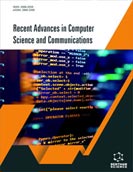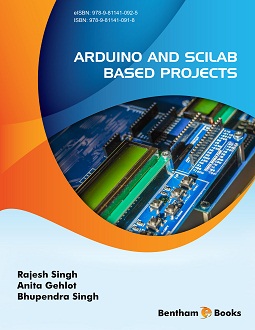Preface
Page: ii-ii (1)
Author: Deepti Chopra and Roopal Khurana
DOI: 10.2174/9789815124422123010002
Introduction to Python
Page: 1-14 (14)
Author: Deepti Chopra and Roopal Khurana
DOI: 10.2174/9789815124422123010003
PDF Price: $15
Abstract
Python is considered one of the most simple and efficient programming
languages. Its object-oriented programming approach and elegant syntax make it a
powerful programming language. Python is an interpreted language. Its dynamic typing
and high level data structures make it an ideal language for application development in
various areas and on multiple platforms. Today, Python is widely used in the areas of
machine learning and data science. The following chapter discusses Python, the utility
of Python in machine learning and data science, ecosystem of Python in machine
learning and various libraries in Python required for machine learning.
Introduction To Machine Learning
Page: 15-29 (15)
Author: Deepti Chopra and Roopal Khurana
DOI: 10.2174/9789815124422123010004
PDF Price: $15
Abstract
Machine Learning is referred to as the subset of Artificial Intelligence. It
involves a machine being learned without programming it explicitly. In Machine
Learning, machines try to improve their performance with the help of past experiences
or by using training examples. The following chapter discusses Machine Learning,
Selection of training set, Selection of target function, Selection of Function
Approximation Algorithm, Perspectives and issues involved while building a machine
learning system,In-sample and Out-of-sample error and Applications of Machine
Learning.
Linear Regression and Logistic Regression
Page: 30-57 (28)
Author: Deepti Chopra and Roopal Khurana
DOI: 10.2174/9789815124422123010005
PDF Price: $15
Abstract
Supervised learning is a machine learning task of mapping the input to the
output on the basis of labeled input-output example pairs. Supervised learning may be
of two types: classification and regression. In this chapter, we will discuss linear
regression in one variable, linear regression in multiple variables, gradient descent, and
polynomial regression.
Support Vector Machine
Page: 58-73 (16)
Author: Deepti Chopra and Roopal Khurana
DOI: 10.2174/9789815124422123010006
PDF Price: $15
Abstract
Support Vector Machine (SVM) may be defined as a machine learning
algorithm that can be used for regression and classification. It is generally used for
classification purposes. In this chapter, we will discuss Margin and Large Margin
Methods and Kernel Methods.
Decision Trees
Page: 74-82 (9)
Author: Deepti Chopra and Roopal Khurana
DOI: 10.2174/9789815124422123010007
PDF Price: $15
Abstract
Neural networks are a way to mimic the working of a human brain. Decision
trees refer to the decision support structure that uses a tree to make decisions and draw
all possible consequences. Decision trees are a way to display conditional control
statements. In the following chapter, we will discuss decision trees, regression trees,
stopping criterion and pruning loss functions in a decision tree, categorical attributes,
multiway splits and missing values in decision trees, and instability in decision trees.
Neural Network
Page: 83-96 (14)
Author: Deepti Chopra and Roopal Khurana
DOI: 10.2174/9789815124422123010008
PDF Price: $15
Abstract
A Support Vector Machine is used for the purpose of classification and
regression. In the previous chapter, we discussed Support Vector Machine, margin and
large margin methods, and kernel methods. A neural network refers to a parallel
computing device that attempts to mimic the model of the brain. In the following
chapter, we will discuss the early models of Neural Networks as well as the Perceptron
learning model, back propagation, and Stochastic Gradient Descent.
Supervised Learning
Page: 97-102 (6)
Author: Deepti Chopra and Roopal Khurana
DOI: 10.2174/9789815124422123010009
PDF Price: $15
Abstract
Supervised learning involves training using well “labelled” training data, and on the basis of the training data, machines are able to predict the output. The labelled data means that the correct output is attached along with the corresponding input data. In supervised learning, as the name suggests, the training data acts as the supervisor and provides training to the machine to predict the correct output. This chapter discusses Statistical Decision Theory, Gaussian & Normal Distribution, Conditionally Independent Binary Components, Learning Beliefs Network and Nearest-Neighbour Methods.
Unsupervised Learning
Page: 103-112 (10)
Author: Deepti Chopra and Roopal Khurana
DOI: 10.2174/9789815124422123010010
PDF Price: $15
Abstract
Unsupervised learning is a complex processing task involving the
identification of patterns in datasets having data points that are neither labeled nor
classified. Unsupervised learning is a kind of machine learning algorithm that can be
used to draw useful conclusions without the presence of labeled responses in the input
data. In the following chapter, we will discuss Clustering (K-means Clustering,
Hierarchical Clustering), and Principal Component Analysis.
Theory of Generalisation
Page: 113-115 (3)
Author: Deepti Chopra and Roopal Khurana
DOI: 10.2174/9789815124422123010011
PDF Price: $15
Abstract
Unsupervised learning is a kind of machine learning algorithm that can be
used to draw useful conclusions without the presence of labeled responses in the input
data. In the previous chapter, we discussed clustering (k-means clustering, hierarchical
clustering) and Principal Component Analysis. In this chapter, we will discuss training
versus testing, bounding the testing error, and the VC dimension.
Bias and Fairness in Ml
Page: 116-122 (7)
Author: Deepti Chopra and Roopal Khurana
DOI: 10.2174/9789815124422123010012
PDF Price: $15
Abstract
In machine learning and AI, future predictions are based on past
observations, and bias is based on prior information. Harmful biases occur because of
human biases which are learned by an algorithm from the training data. In the previous
chapter, we discussed training versus testing, bounding the testing error, and VC
dimension. In this chapter, we will discuss bias and fairness.
Appendix
Page: 123-123 (1)
Author: Deepti Chopra and Roopal Khurana
DOI: 10.2174/9789815124422123010013
Subject Index
Page: 124-127 (4)
Author: Deepti Chopra and Roopal Khurana
DOI: 10.2174/9789815124422123010014
Introduction
Machine learning is a subfield of artificial intelligence, broadly defined as a machine's capability to imitate intelligent human behavior. Like humans, machines become capable of making intelligent decisions by learning from their past experiences. Machine learning is being employed in many applications, including fraud detection and prevention, self-driving cars, recommendation systems, facial recognition technology, and intelligent computing. This book helps beginners learn the art and science of machine learning. It presens real-world examples that leverage the popular Python machine learning ecosystem, The topics covered in this book include machine learning basics: supervised and unsupervised learning, linear regression and logistic regression, Support Vector Machines (SVMs). It also delves into special topics such as neural networks, theory of generalisation, and bias and fairness in machine learning. After reading this book, computer science and engineering students - at college and university levels - will receive a complete understanding of machine learning fundamentals and will be able to implement neural network solutions in information systems, and also extend them to their advantage.






















